

Compact Muon Solenoid
LHC, CERN
| CMS-PAS-SMP-22-001 | ||
| Measurement of the differential ZZ+jets production cross sections in pp collisions at $ \sqrt{s} = $ 13 TeV | ||
| CMS Collaboration | ||
| 21 May 2023 | ||
| Abstract: Diboson ZZ production in association with jets in the fully leptonic final states in proton-proton collisions, $ \textrm{pp} \to (\textrm{Z}/\gamma^*)(\textrm{Z}/\gamma^*) \to 2\ell2\ell' $, ($ \ell,\ell' =$ e or $ \mu $), is studied at a center-of-mass energy of 13 TeV. The data sample corresponds to an integrated luminosity of 138 fb$ ^{-1} $ collected during 2016-2018 with the CMS detector at the LHC. Differential distributions and normalized differential cross sections are measured as a function of the number of jets, as a function of the transverse momentum $ p_{\mathrm{T}} $, pseudorapidity $ \eta $, invariant mass and $ \Delta\eta $ of the highest-$ p_{\mathrm{T}} $ and second-highest-$ p_{\mathrm{T}} $ jets, and as a function of the invariant mass of the four leptons with different jet multiplicities, and compared to theoretical predictions. The predictions in general agree with the data, but in some regions significant discrepancies between predicted and measured values are observed. | ||
|
Links:
CDS record (PDF) ;
Physics Briefing ;
CADI line (restricted) ;
These preliminary results are superseded in this paper, Submitted to JHEP. The superseded preliminary plots can be found here. |
||
| Figures | |

png pdf |
Figure 1:
Distribution of the number of jets with $ p_{\mathrm{T}} > $ 30 GeV (left) and of $ m_{\mathrm{Z}\mathrm{Z}} $ (right) for ZZ + jets events with 60 $ < m_{\mathrm{Z}_1, \mathrm{Z}_2} < $ 120 GeV for the combined 4e, 4$ \mu $, and 2e2$ \mu $ decay channels. Points represent the data, vertical bars the statistical uncertainties, and shaded histograms represent the expected standard model predictions and reducible background estimated from data. The gray band represents the systematic uncertainties in the predictions, which includes systematic uncertainties associated with trigger efficiency, lepton efficiencies, jet energy correction and jet energy resolution, pileup, luminosity, Monte Carlo generator choice, $ gg \to ZZ $ cross section, and reducible background. Overflow is included in the last bin of the distributions. |
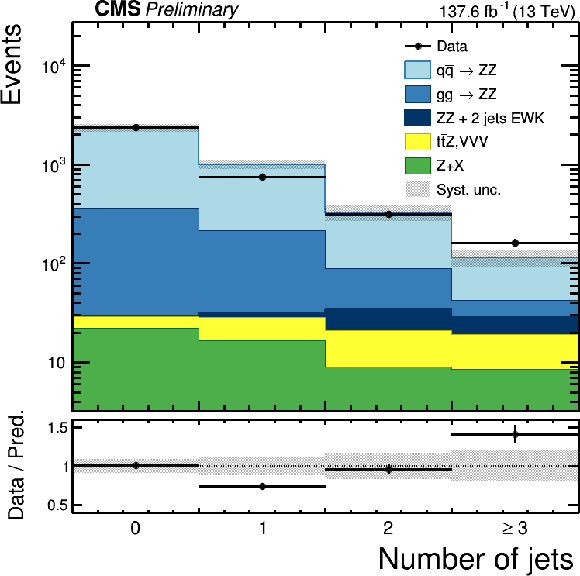
png |
Figure 1-a:
Distribution of the number of jets with $ p_{\mathrm{T}} > $ 30 GeV (left) and of $ m_{\mathrm{Z}\mathrm{Z}} $ (right) for ZZ + jets events with 60 $ < m_{\mathrm{Z}_1, \mathrm{Z}_2} < $ 120 GeV for the combined 4e, 4$ \mu $, and 2e2$ \mu $ decay channels. Points represent the data, vertical bars the statistical uncertainties, and shaded histograms represent the expected standard model predictions and reducible background estimated from data. The gray band represents the systematic uncertainties in the predictions, which includes systematic uncertainties associated with trigger efficiency, lepton efficiencies, jet energy correction and jet energy resolution, pileup, luminosity, Monte Carlo generator choice, $ gg \to ZZ $ cross section, and reducible background. Overflow is included in the last bin of the distributions. |

png |
Figure 1-b:
Distribution of the number of jets with $ p_{\mathrm{T}} > $ 30 GeV (left) and of $ m_{\mathrm{Z}\mathrm{Z}} $ (right) for ZZ + jets events with 60 $ < m_{\mathrm{Z}_1, \mathrm{Z}_2} < $ 120 GeV for the combined 4e, 4$ \mu $, and 2e2$ \mu $ decay channels. Points represent the data, vertical bars the statistical uncertainties, and shaded histograms represent the expected standard model predictions and reducible background estimated from data. The gray band represents the systematic uncertainties in the predictions, which includes systematic uncertainties associated with trigger efficiency, lepton efficiencies, jet energy correction and jet energy resolution, pileup, luminosity, Monte Carlo generator choice, $ gg \to ZZ $ cross section, and reducible background. Overflow is included in the last bin of the distributions. |
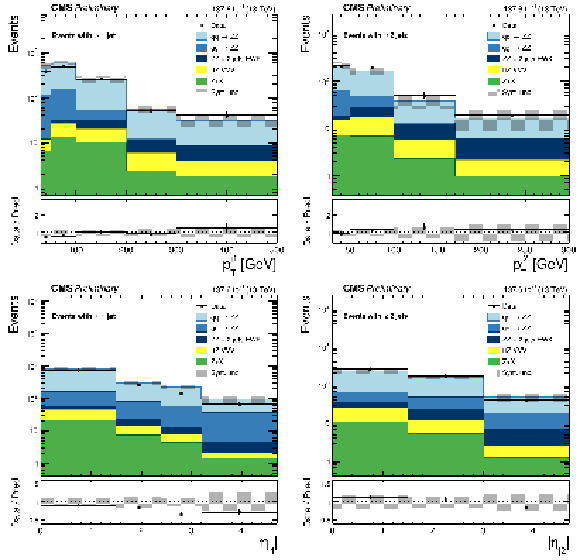
png pdf |
Figure 2:
Distribution of the $ p_{\mathrm{T}} $ of the highest-$ p_{\mathrm{T}} $ jet (top left) in events with at least one jet, the $ p_{\mathrm{T}} $ of the second-highest-$ p_{\mathrm{T}} $ jet (top right) in events containing at least two jets. The $ |\eta| $ of the highest-$ p_{\mathrm{T}} $ (bottom left) and second-highest-$ p_{\mathrm{T}} $ (bottom right) jets. Events with 60 $ < m_{\mathrm{Z}_1, \mathrm{Z}_2} < $ 120 GeV requirement. Other details as in the caption of Fig. 1. |
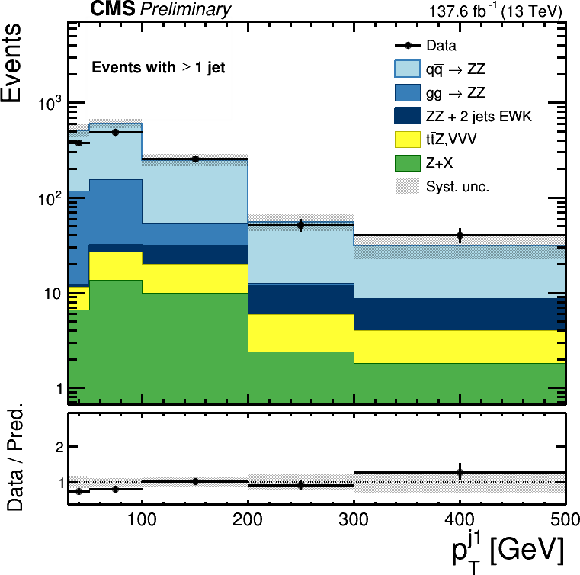
png |
Figure 2-a:
Distribution of the $ p_{\mathrm{T}} $ of the highest-$ p_{\mathrm{T}} $ jet (top left) in events with at least one jet, the $ p_{\mathrm{T}} $ of the second-highest-$ p_{\mathrm{T}} $ jet (top right) in events containing at least two jets. The $ |\eta| $ of the highest-$ p_{\mathrm{T}} $ (bottom left) and second-highest-$ p_{\mathrm{T}} $ (bottom right) jets. Events with 60 $ < m_{\mathrm{Z}_1, \mathrm{Z}_2} < $ 120 GeV requirement. Other details as in the caption of Fig. 1. |
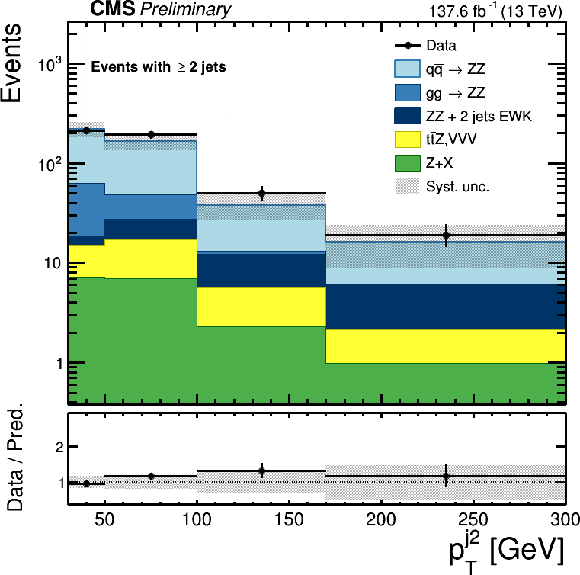
png |
Figure 2-b:
Distribution of the $ p_{\mathrm{T}} $ of the highest-$ p_{\mathrm{T}} $ jet (top left) in events with at least one jet, the $ p_{\mathrm{T}} $ of the second-highest-$ p_{\mathrm{T}} $ jet (top right) in events containing at least two jets. The $ |\eta| $ of the highest-$ p_{\mathrm{T}} $ (bottom left) and second-highest-$ p_{\mathrm{T}} $ (bottom right) jets. Events with 60 $ < m_{\mathrm{Z}_1, \mathrm{Z}_2} < $ 120 GeV requirement. Other details as in the caption of Fig. 1. |
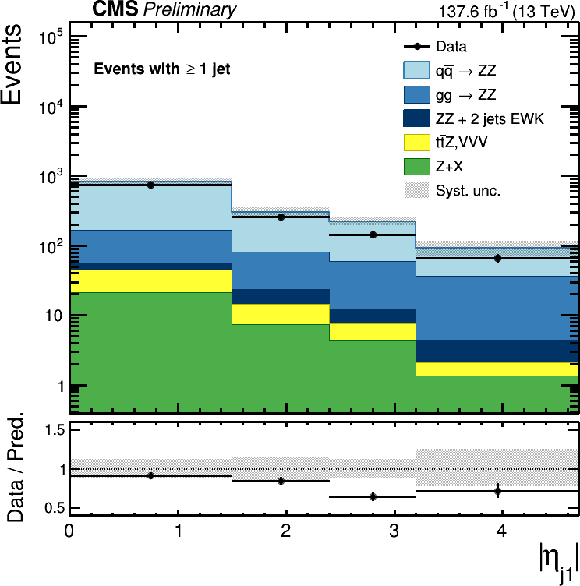
png |
Figure 2-c:
Distribution of the $ p_{\mathrm{T}} $ of the highest-$ p_{\mathrm{T}} $ jet (top left) in events with at least one jet, the $ p_{\mathrm{T}} $ of the second-highest-$ p_{\mathrm{T}} $ jet (top right) in events containing at least two jets. The $ |\eta| $ of the highest-$ p_{\mathrm{T}} $ (bottom left) and second-highest-$ p_{\mathrm{T}} $ (bottom right) jets. Events with 60 $ < m_{\mathrm{Z}_1, \mathrm{Z}_2} < $ 120 GeV requirement. Other details as in the caption of Fig. 1. |
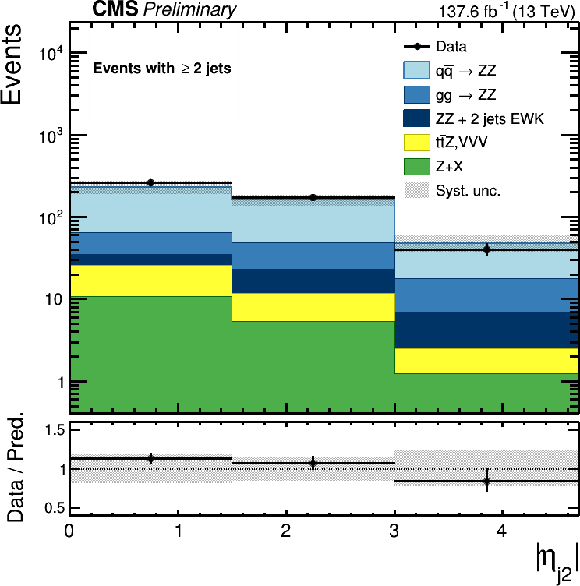
png |
Figure 2-d:
Distribution of the $ p_{\mathrm{T}} $ of the highest-$ p_{\mathrm{T}} $ jet (top left) in events with at least one jet, the $ p_{\mathrm{T}} $ of the second-highest-$ p_{\mathrm{T}} $ jet (top right) in events containing at least two jets. The $ |\eta| $ of the highest-$ p_{\mathrm{T}} $ (bottom left) and second-highest-$ p_{\mathrm{T}} $ (bottom right) jets. Events with 60 $ < m_{\mathrm{Z}_1, \mathrm{Z}_2} < $ 120 GeV requirement. Other details as in the caption of Fig. 1. |
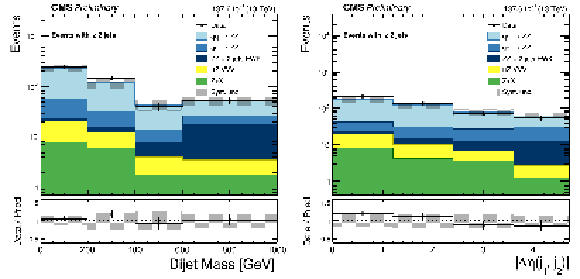
png pdf |
Figure 3:
The dijet mass (left) and $ |\Delta \eta | $ (right) between highest-$ p_{\mathrm{T}} $ jets in events with at least two jets. Events with 60 $ < m_{\mathrm{Z}_1, \mathrm{Z}_2} < $ 120 GeV requirement. Other details as in the caption of Fig. 1. |
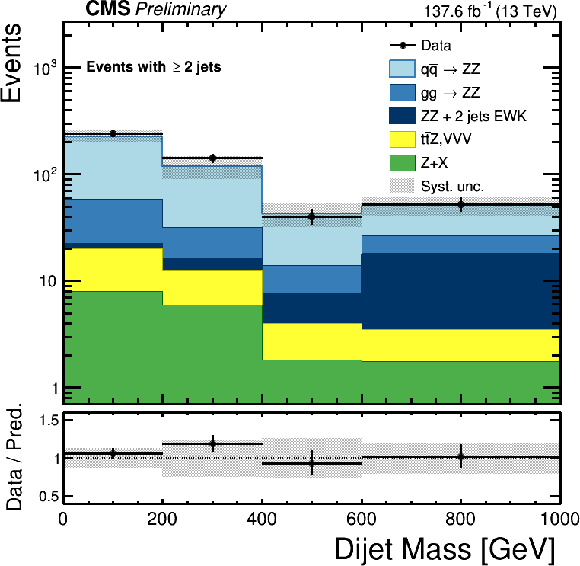
png |
Figure 3-a:
The dijet mass (left) and $ |\Delta \eta | $ (right) between highest-$ p_{\mathrm{T}} $ jets in events with at least two jets. Events with 60 $ < m_{\mathrm{Z}_1, \mathrm{Z}_2} < $ 120 GeV requirement. Other details as in the caption of Fig. 1. |
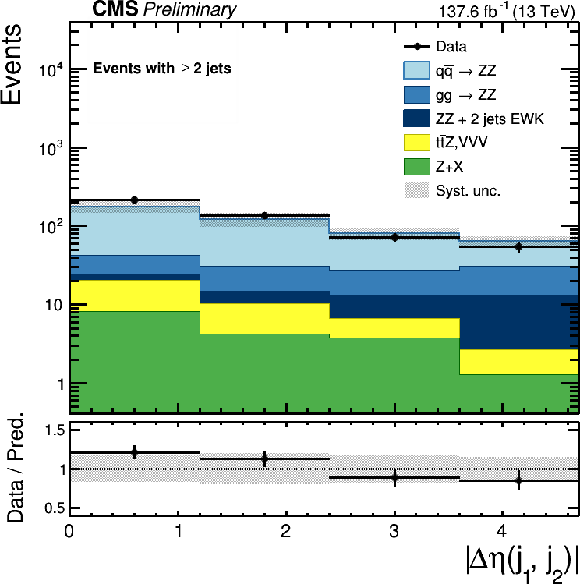
png |
Figure 3-b:
The dijet mass (left) and $ |\Delta \eta | $ (right) between highest-$ p_{\mathrm{T}} $ jets in events with at least two jets. Events with 60 $ < m_{\mathrm{Z}_1, \mathrm{Z}_2} < $ 120 GeV requirement. Other details as in the caption of Fig. 1. |
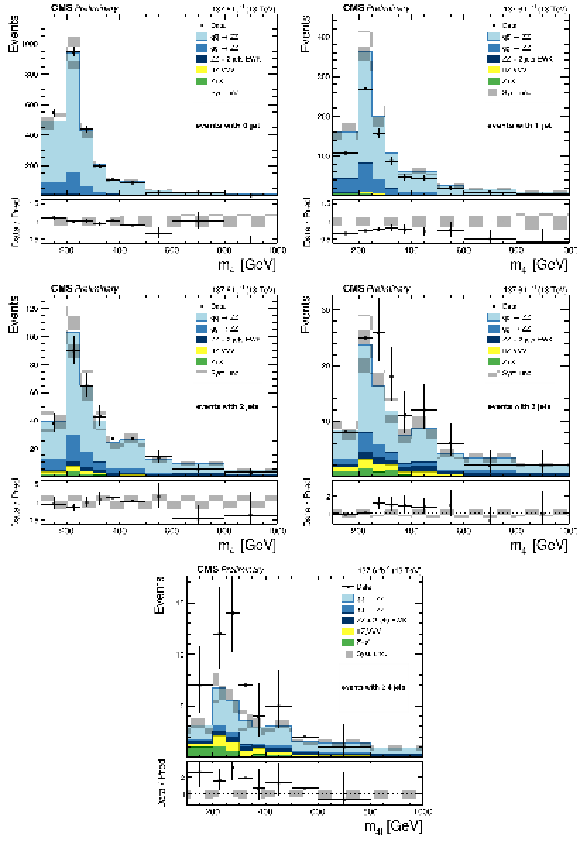
png pdf |
Figure 4:
The $ m_{4\ell} $ distributions for events with 60 $ < m_{\mathrm{Z}_1, \mathrm{Z}_2} < $ 120 GeV and different number of jets. Other details as in the caption of Fig. 1. |

png |
Figure 4-a:
The $ m_{4\ell} $ distributions for events with 60 $ < m_{\mathrm{Z}_1, \mathrm{Z}_2} < $ 120 GeV and different number of jets. Other details as in the caption of Fig. 1. |
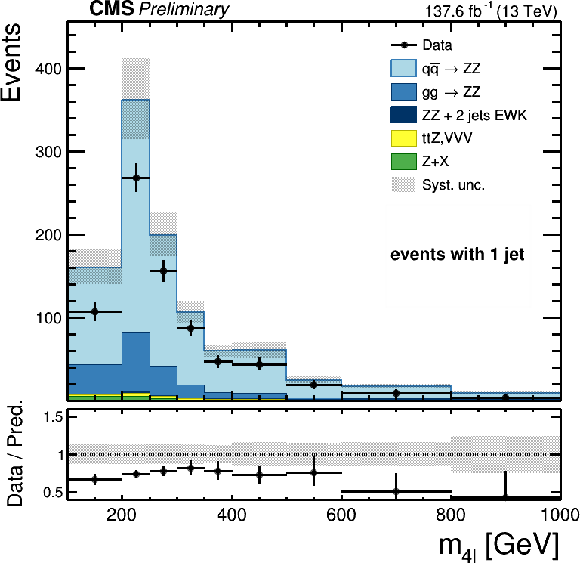
png |
Figure 4-b:
The $ m_{4\ell} $ distributions for events with 60 $ < m_{\mathrm{Z}_1, \mathrm{Z}_2} < $ 120 GeV and different number of jets. Other details as in the caption of Fig. 1. |

png |
Figure 4-c:
The $ m_{4\ell} $ distributions for events with 60 $ < m_{\mathrm{Z}_1, \mathrm{Z}_2} < $ 120 GeV and different number of jets. Other details as in the caption of Fig. 1. |
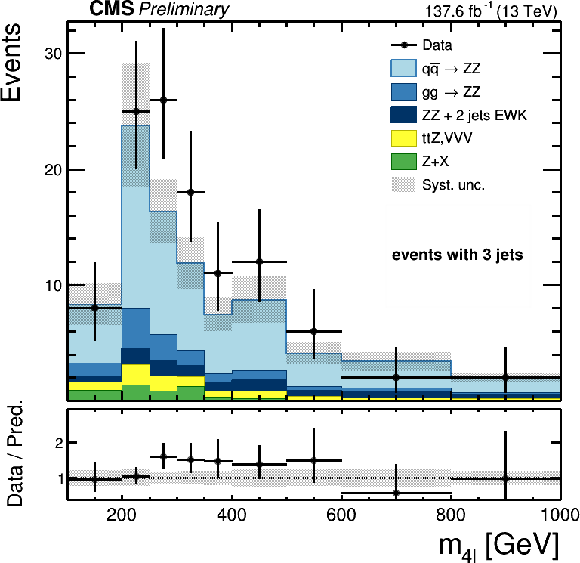
png |
Figure 4-d:
The $ m_{4\ell} $ distributions for events with 60 $ < m_{\mathrm{Z}_1, \mathrm{Z}_2} < $ 120 GeV and different number of jets. Other details as in the caption of Fig. 1. |

png |
Figure 4-e:
The $ m_{4\ell} $ distributions for events with 60 $ < m_{\mathrm{Z}_1, \mathrm{Z}_2} < $ 120 GeV and different number of jets. Other details as in the caption of Fig. 1. |
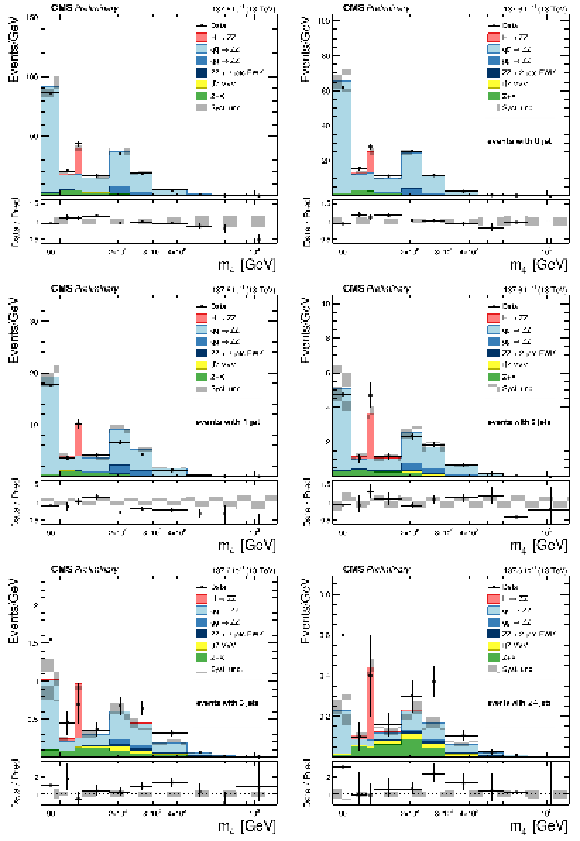
png pdf |
Figure 5:
The $ m_{4\ell} $ distributions in the full available four-lepton invariant mass range for events with different number of jets, normalized by bin width. Other details as in the caption of Fig. 1. |

png |
Figure 5-a:
The $ m_{4\ell} $ distributions in the full available four-lepton invariant mass range for events with different number of jets, normalized by bin width. Other details as in the caption of Fig. 1. |
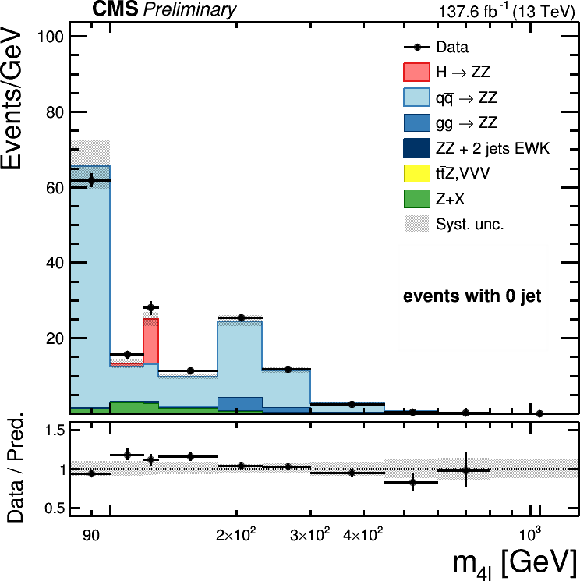
png |
Figure 5-b:
The $ m_{4\ell} $ distributions in the full available four-lepton invariant mass range for events with different number of jets, normalized by bin width. Other details as in the caption of Fig. 1. |
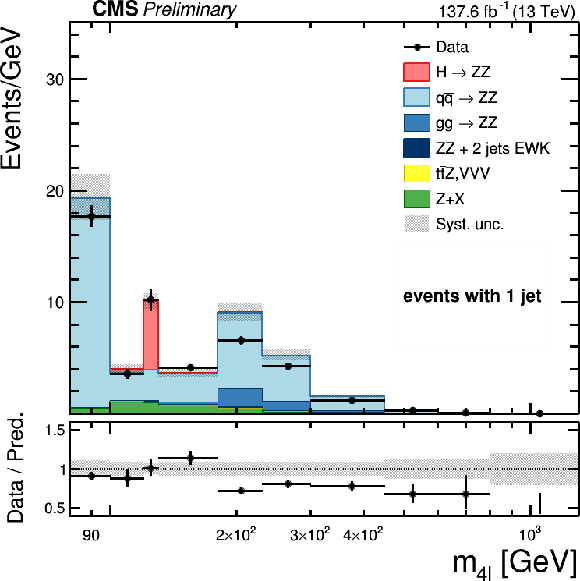
png |
Figure 5-c:
The $ m_{4\ell} $ distributions in the full available four-lepton invariant mass range for events with different number of jets, normalized by bin width. Other details as in the caption of Fig. 1. |
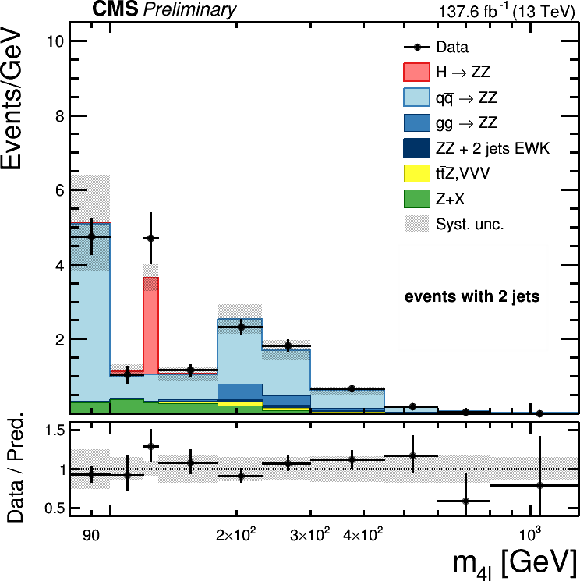
png |
Figure 5-d:
The $ m_{4\ell} $ distributions in the full available four-lepton invariant mass range for events with different number of jets, normalized by bin width. Other details as in the caption of Fig. 1. |
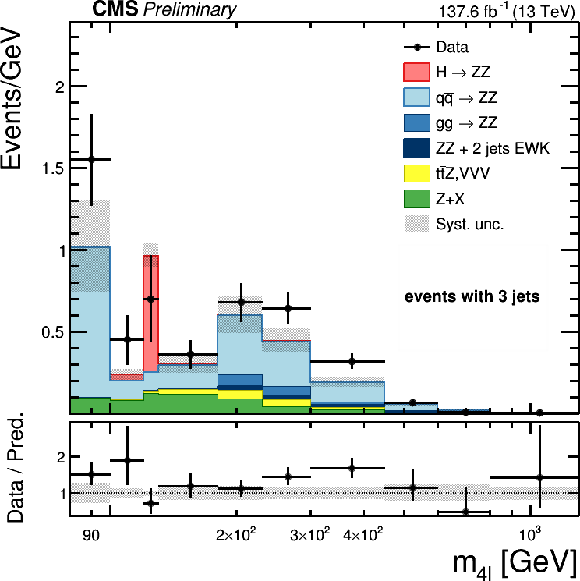
png |
Figure 5-e:
The $ m_{4\ell} $ distributions in the full available four-lepton invariant mass range for events with different number of jets, normalized by bin width. Other details as in the caption of Fig. 1. |
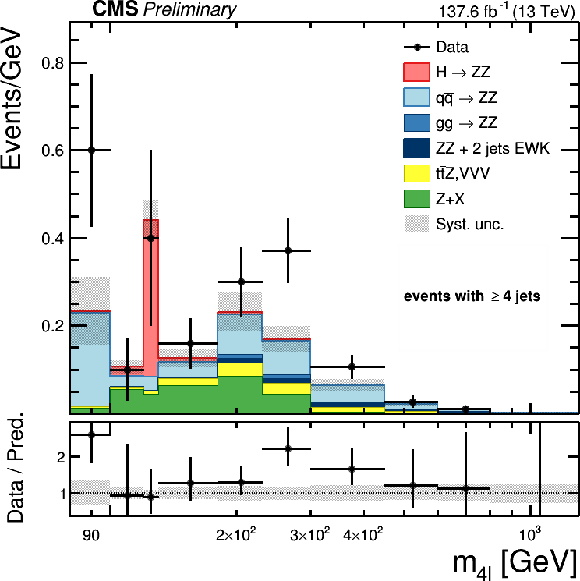
png |
Figure 5-f:
The $ m_{4\ell} $ distributions in the full available four-lepton invariant mass range for events with different number of jets, normalized by bin width. Other details as in the caption of Fig. 1. |
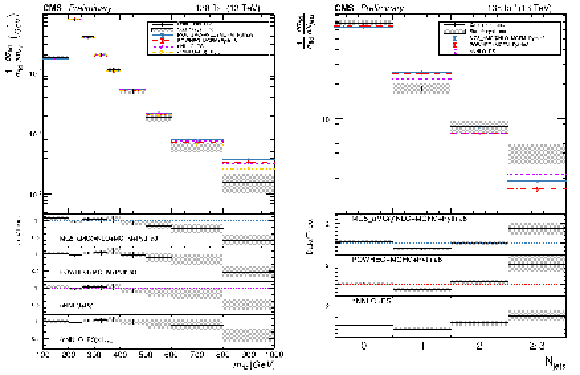
png pdf |
Figure 6:
Differential cross sections normalized to the fiducial cross section as a function of (left) the $ m_{4\ell} $, (right) the number of jets with $ p_{\mathrm{T}} > $ 30 GeV in the events. The on-shell Z requirement 60 $ < m_{\mathrm{Z}_1, \mathrm{Z}_2} < $ 120 GeV is applied. Points represent the unfolded data, the solid histograms the (MadGraph5_aMC@NLO $ \mathrm{q}\overline{\mathrm{q}} \to \mathrm{Z}\mathrm{Z} $)+(MCFM $\mathrm{G}\mathrm{G} \to \mathrm{Z}\mathrm{Z}$)+( POWHEG $ \mathrm{H} \to \mathrm{Z}\mathrm{Z} $) predictions, and red dashed histograms the (POWHEG $ \mathrm{q}\overline{\mathrm{q}} \to \mathrm{Z}\mathrm{Z} $)+(MCFM $ \mathrm{g}\mathrm{g} \to \mathrm{Z}\mathrm{Z} $)+(POWHEG $ \mathrm{H} \to \mathrm{Z}\mathrm{Z} $) predictions. MadGraph EW ZZ predictions are included in these two sets of predictions. The purple dashed histograms represent the nNNLO+PS predictions, and the yellow dashed histogram represents the nNNLO+PS prediction with EW corrections applied. Vertical bars on both MC predictions represent the statistical uncertainties. The lower panels show the ratio of the measured to the predicted cross sections. The shaded areas represent the full uncertainties calculated as the sum in quadrature of the statistical and systematic uncertainties, while the crosses represent the statistical uncertainties only. Overflow is included in the last bin of the distributions. |
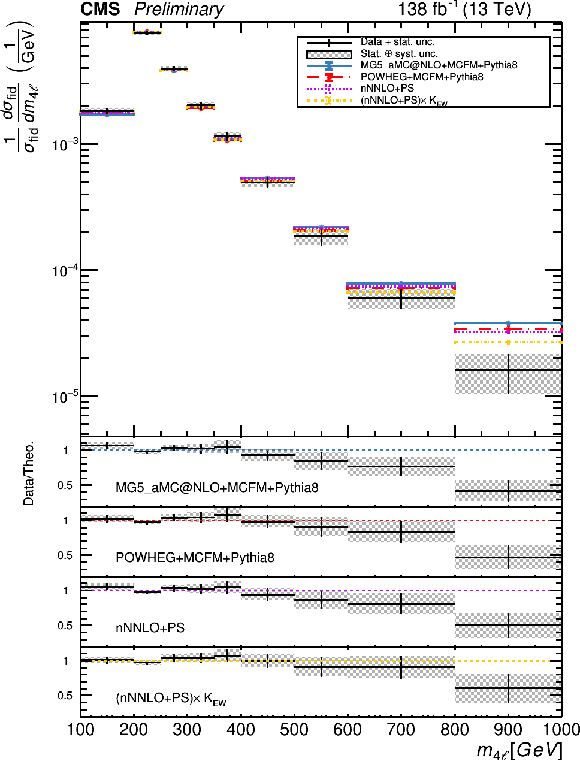
png |
Figure 6-a:
Differential cross sections normalized to the fiducial cross section as a function of (left) the $ m_{4\ell} $, (right) the number of jets with $ p_{\mathrm{T}} > $ 30 GeV in the events. The on-shell Z requirement 60 $ < m_{\mathrm{Z}_1, \mathrm{Z}_2} < $ 120 GeV is applied. Points represent the unfolded data, the solid histograms the (MadGraph5_aMC@NLO $ \mathrm{q}\overline{\mathrm{q}} \to \mathrm{Z}\mathrm{Z} $)+(MCFM $\mathrm{G}\mathrm{G} \to \mathrm{Z}\mathrm{Z}$)+( POWHEG $ \mathrm{H} \to \mathrm{Z}\mathrm{Z} $) predictions, and red dashed histograms the (POWHEG $ \mathrm{q}\overline{\mathrm{q}} \to \mathrm{Z}\mathrm{Z} $)+(MCFM $ \mathrm{g}\mathrm{g} \to \mathrm{Z}\mathrm{Z} $)+(POWHEG $ \mathrm{H} \to \mathrm{Z}\mathrm{Z} $) predictions. MadGraph EW ZZ predictions are included in these two sets of predictions. The purple dashed histograms represent the nNNLO+PS predictions, and the yellow dashed histogram represents the nNNLO+PS prediction with EW corrections applied. Vertical bars on both MC predictions represent the statistical uncertainties. The lower panels show the ratio of the measured to the predicted cross sections. The shaded areas represent the full uncertainties calculated as the sum in quadrature of the statistical and systematic uncertainties, while the crosses represent the statistical uncertainties only. Overflow is included in the last bin of the distributions. |

png |
Figure 6-b:
Differential cross sections normalized to the fiducial cross section as a function of (left) the $ m_{4\ell} $, (right) the number of jets with $ p_{\mathrm{T}} > $ 30 GeV in the events. The on-shell Z requirement 60 $ < m_{\mathrm{Z}_1, \mathrm{Z}_2} < $ 120 GeV is applied. Points represent the unfolded data, the solid histograms the (MadGraph5_aMC@NLO $ \mathrm{q}\overline{\mathrm{q}} \to \mathrm{Z}\mathrm{Z} $)+(MCFM $\mathrm{G}\mathrm{G} \to \mathrm{Z}\mathrm{Z}$)+( POWHEG $ \mathrm{H} \to \mathrm{Z}\mathrm{Z} $) predictions, and red dashed histograms the (POWHEG $ \mathrm{q}\overline{\mathrm{q}} \to \mathrm{Z}\mathrm{Z} $)+(MCFM $ \mathrm{g}\mathrm{g} \to \mathrm{Z}\mathrm{Z} $)+(POWHEG $ \mathrm{H} \to \mathrm{Z}\mathrm{Z} $) predictions. MadGraph EW ZZ predictions are included in these two sets of predictions. The purple dashed histograms represent the nNNLO+PS predictions, and the yellow dashed histogram represents the nNNLO+PS prediction with EW corrections applied. Vertical bars on both MC predictions represent the statistical uncertainties. The lower panels show the ratio of the measured to the predicted cross sections. The shaded areas represent the full uncertainties calculated as the sum in quadrature of the statistical and systematic uncertainties, while the crosses represent the statistical uncertainties only. Overflow is included in the last bin of the distributions. |

png pdf |
Figure 7:
Differential cross sections normalized to the fiducial cross section as a function of $ p_{\mathrm{T}} $ and $ |\eta| $ of the highest- and the second-highest-$ p_{\mathrm{T}} $ jet in events containing at least one or two jets, respectively. The on-shell Z requirement 60 $ < m_{\mathrm{Z}_1, \mathrm{Z}_2} < $ 120 GeV is applied. Other details as in the caption of Fig. 6. |

png |
Figure 7-a:
Differential cross sections normalized to the fiducial cross section as a function of $ p_{\mathrm{T}} $ and $ |\eta| $ of the highest- and the second-highest-$ p_{\mathrm{T}} $ jet in events containing at least one or two jets, respectively. The on-shell Z requirement 60 $ < m_{\mathrm{Z}_1, \mathrm{Z}_2} < $ 120 GeV is applied. Other details as in the caption of Fig. 6. |

png |
Figure 7-b:
Differential cross sections normalized to the fiducial cross section as a function of $ p_{\mathrm{T}} $ and $ |\eta| $ of the highest- and the second-highest-$ p_{\mathrm{T}} $ jet in events containing at least one or two jets, respectively. The on-shell Z requirement 60 $ < m_{\mathrm{Z}_1, \mathrm{Z}_2} < $ 120 GeV is applied. Other details as in the caption of Fig. 6. |
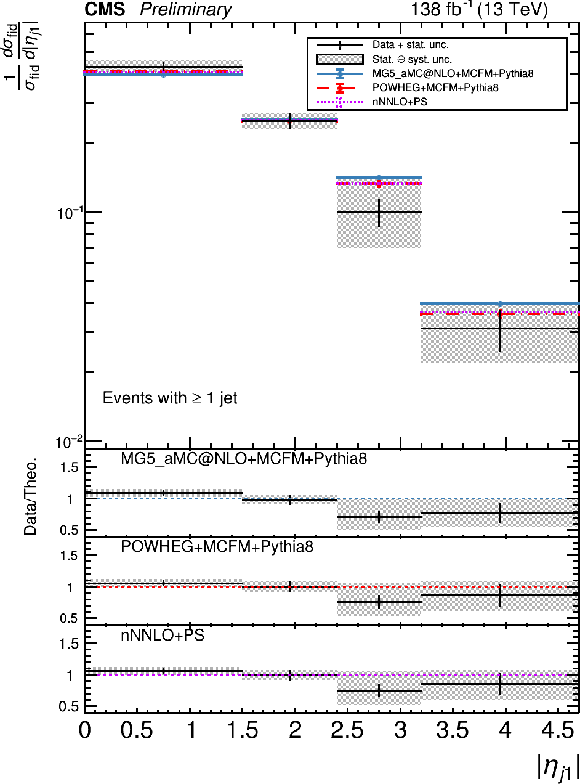
png |
Figure 7-c:
Differential cross sections normalized to the fiducial cross section as a function of $ p_{\mathrm{T}} $ and $ |\eta| $ of the highest- and the second-highest-$ p_{\mathrm{T}} $ jet in events containing at least one or two jets, respectively. The on-shell Z requirement 60 $ < m_{\mathrm{Z}_1, \mathrm{Z}_2} < $ 120 GeV is applied. Other details as in the caption of Fig. 6. |
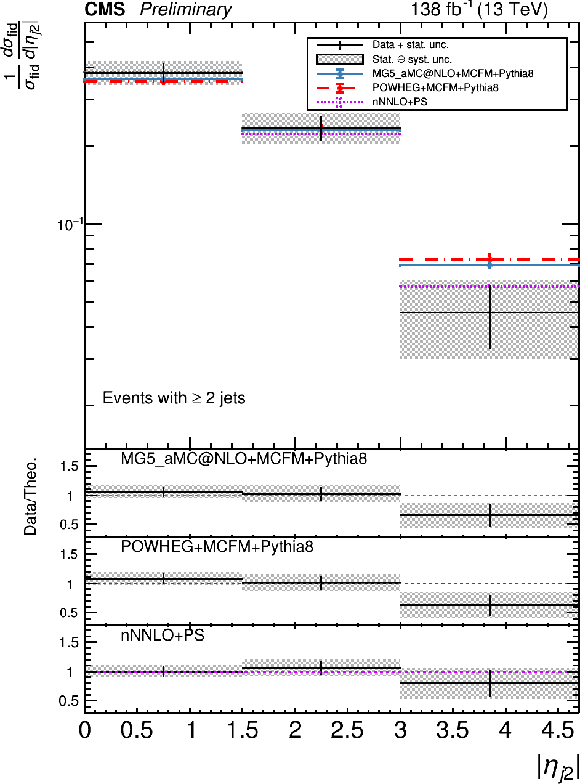
png |
Figure 7-d:
Differential cross sections normalized to the fiducial cross section as a function of $ p_{\mathrm{T}} $ and $ |\eta| $ of the highest- and the second-highest-$ p_{\mathrm{T}} $ jet in events containing at least one or two jets, respectively. The on-shell Z requirement 60 $ < m_{\mathrm{Z}_1, \mathrm{Z}_2} < $ 120 GeV is applied. Other details as in the caption of Fig. 6. |
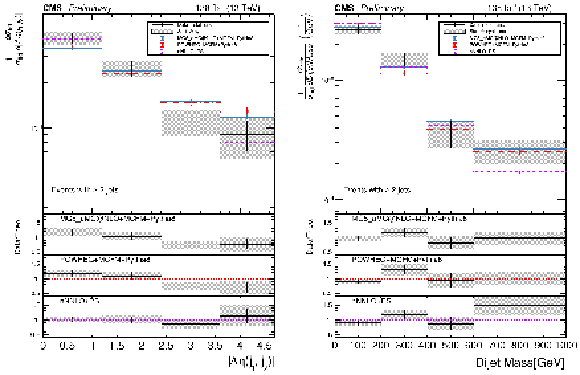
png pdf |
Figure 8:
Differential cross sections normalized to the fiducial cross section as a function of (left) $ | \Delta \eta | $ and (right) dijet mass between highest-$ p_{\mathrm{T}} $ jets in events with at least two jets. Events with 60 $ < m_{\mathrm{Z}_1, \mathrm{Z}_2} < $ 120 GeV requirement. Other details as in the caption of Fig. 6. |
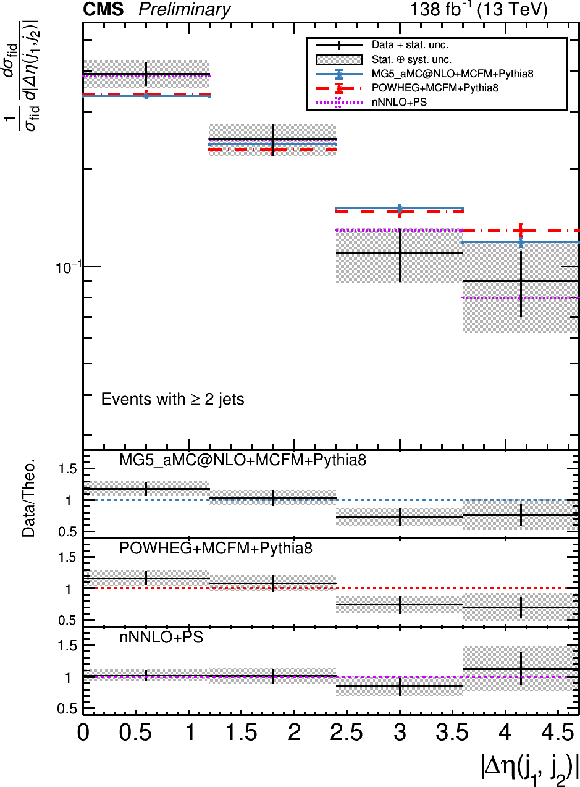
png |
Figure 8-a:
Differential cross sections normalized to the fiducial cross section as a function of (left) $ | \Delta \eta | $ and (right) dijet mass between highest-$ p_{\mathrm{T}} $ jets in events with at least two jets. Events with 60 $ < m_{\mathrm{Z}_1, \mathrm{Z}_2} < $ 120 GeV requirement. Other details as in the caption of Fig. 6. |
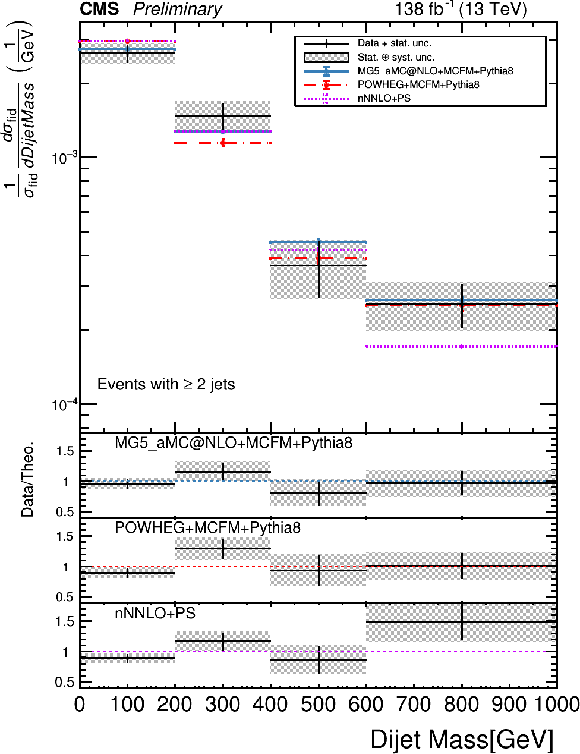
png |
Figure 8-b:
Differential cross sections normalized to the fiducial cross section as a function of (left) $ | \Delta \eta | $ and (right) dijet mass between highest-$ p_{\mathrm{T}} $ jets in events with at least two jets. Events with 60 $ < m_{\mathrm{Z}_1, \mathrm{Z}_2} < $ 120 GeV requirement. Other details as in the caption of Fig. 6. |
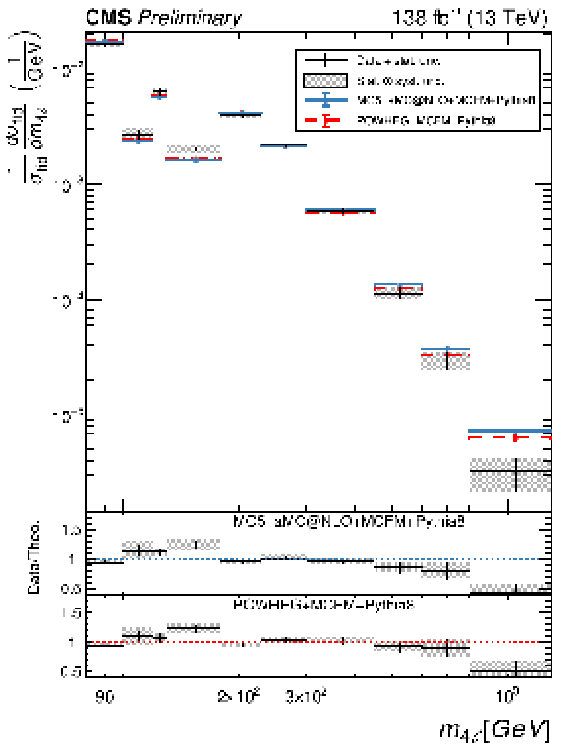
png pdf |
Figure 9:
Differential cross sections normalized to the fiducial cross section as a function of $ m_{4\ell} $ for the full available four-lepton invariant mass range. Other details as in the caption of Fig. 6. |
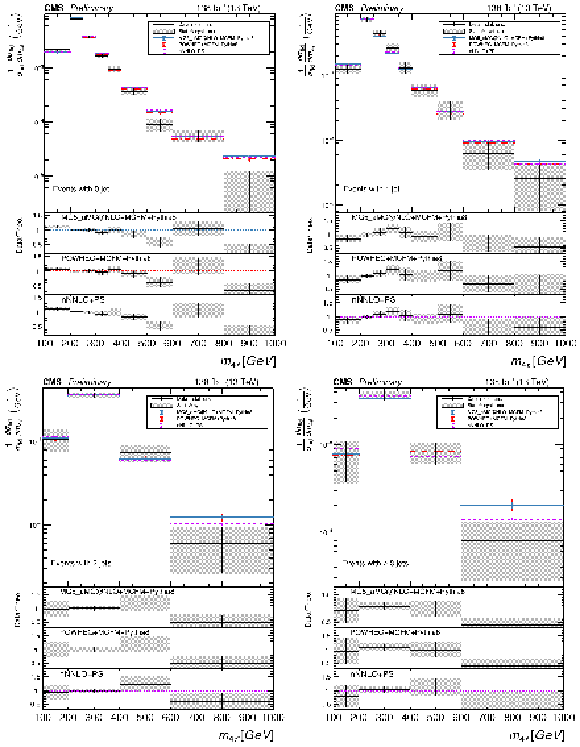
png pdf |
Figure 10:
Differential cross sections normalized to the fiducial cross section as a function of $ m_{4l} $ for 60 $ < m_{\mathrm{Z}_1, \mathrm{Z}_2} < $ 120 GeV and for different number of jets. Other details as in the Fig. 6 caption. |

png |
Figure 10-a:
Differential cross sections normalized to the fiducial cross section as a function of $ m_{4l} $ for 60 $ < m_{\mathrm{Z}_1, \mathrm{Z}_2} < $ 120 GeV and for different number of jets. Other details as in the Fig. 6 caption. |

png |
Figure 10-b:
Differential cross sections normalized to the fiducial cross section as a function of $ m_{4l} $ for 60 $ < m_{\mathrm{Z}_1, \mathrm{Z}_2} < $ 120 GeV and for different number of jets. Other details as in the Fig. 6 caption. |
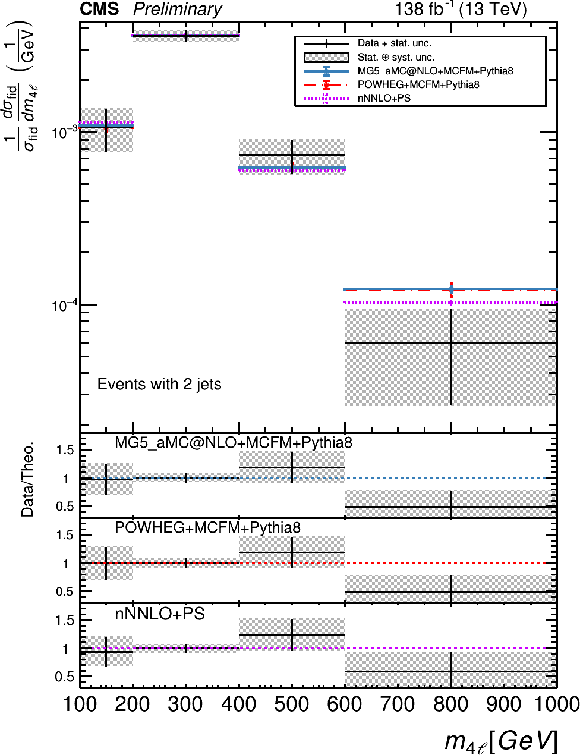
png |
Figure 10-c:
Differential cross sections normalized to the fiducial cross section as a function of $ m_{4l} $ for 60 $ < m_{\mathrm{Z}_1, \mathrm{Z}_2} < $ 120 GeV and for different number of jets. Other details as in the Fig. 6 caption. |
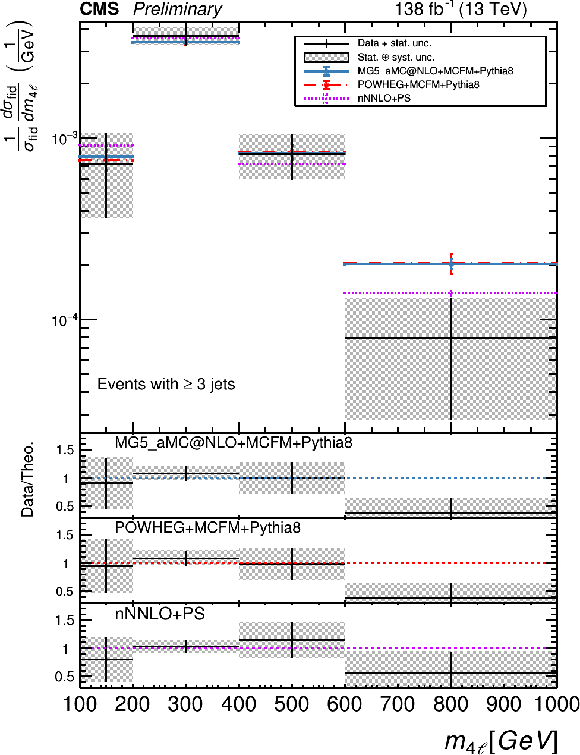
png |
Figure 10-d:
Differential cross sections normalized to the fiducial cross section as a function of $ m_{4l} $ for 60 $ < m_{\mathrm{Z}_1, \mathrm{Z}_2} < $ 120 GeV and for different number of jets. Other details as in the Fig. 6 caption. |
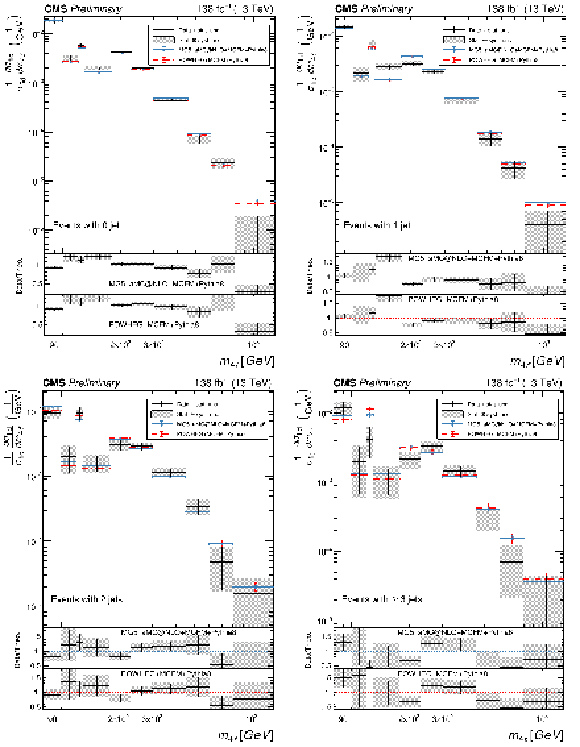
png pdf |
Figure 11:
Differential cross sections normalized to the fiducial cross section as a function of $ m_{4l} $ for the full available four-lepton invariant mass range and different number of jets. Other details as in the Fig. 6 caption. |
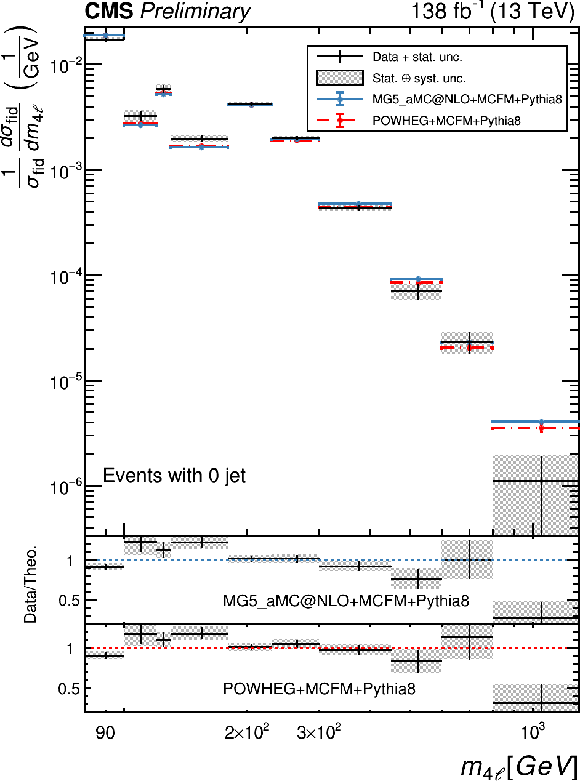
png |
Figure 11-a:
Differential cross sections normalized to the fiducial cross section as a function of $ m_{4l} $ for the full available four-lepton invariant mass range and different number of jets. Other details as in the Fig. 6 caption. |

png |
Figure 11-b:
Differential cross sections normalized to the fiducial cross section as a function of $ m_{4l} $ for the full available four-lepton invariant mass range and different number of jets. Other details as in the Fig. 6 caption. |
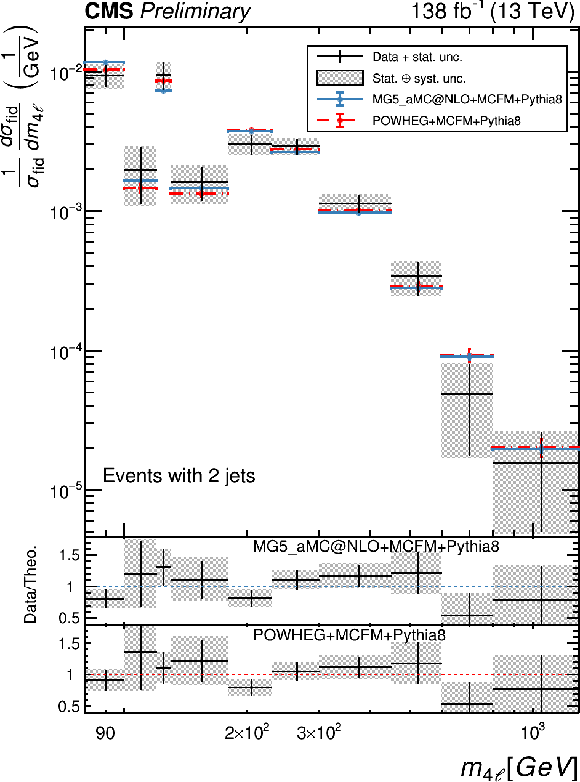
png |
Figure 11-c:
Differential cross sections normalized to the fiducial cross section as a function of $ m_{4l} $ for the full available four-lepton invariant mass range and different number of jets. Other details as in the Fig. 6 caption. |
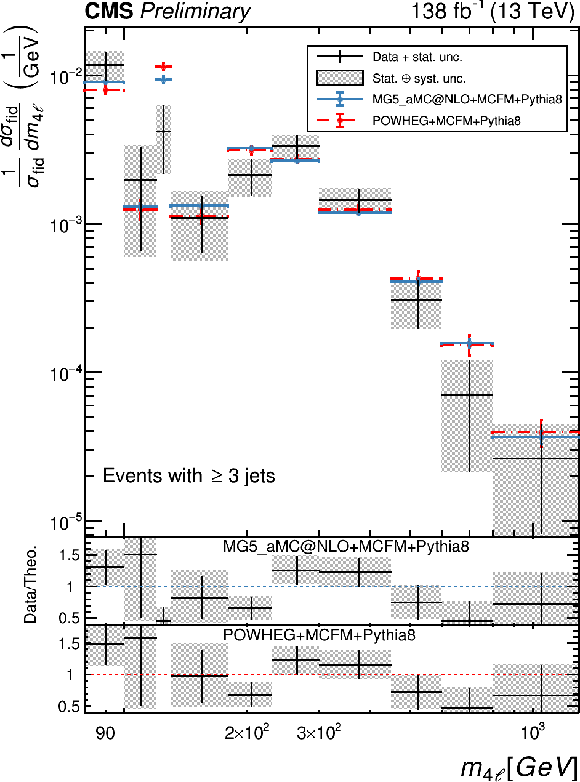
png |
Figure 11-d:
Differential cross sections normalized to the fiducial cross section as a function of $ m_{4l} $ for the full available four-lepton invariant mass range and different number of jets. Other details as in the Fig. 6 caption. |
| Tables | |
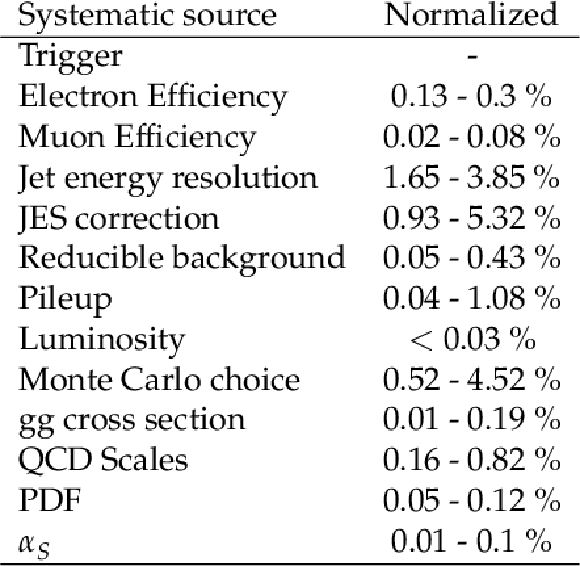
png pdf |
Table 1:
The contributions of each source of systematic uncertainty in the normalized differential cross sections measurements of jet variables. Uncertainties depend on the distributions and are listed as a range. |
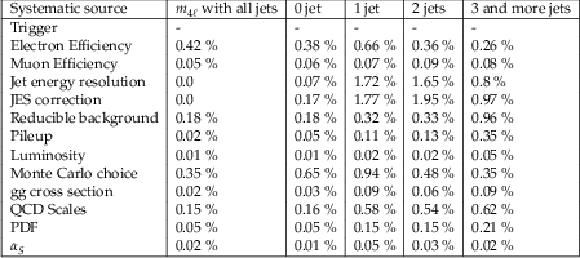
png pdf |
Table 2:
The contributions of each source of systematic uncertainty in the normalized differential cross sections measurements as a function of $ m_{4\ell} $ with jet multiplicity from 0 to 3 and more in events satisfying 60 $ < m_{\mathrm{Z}_1, \mathrm{Z}_2} < $ 120 GeV. |
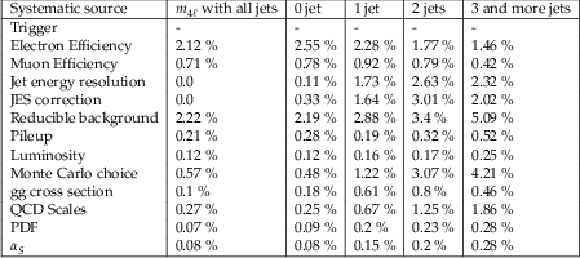
png pdf |
Table 3:
The contributions of each source of systematic uncertainty in the normalized differential cross sections measurements as a function of $ m_{4\ell} $ with jet multiplicity from 0 to 3 and more in events with $ \mathrm{Z}_1$, $\mathrm{Z}_2 $ in the full available four-lepton invariant mass range. |
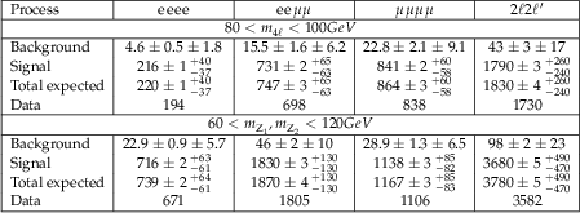
png pdf |
Table 4:
The observed and expected yields of Run2 ZZ events in different mass ranges, and estimated yields of background events, shown for each final state and the total. The statistical (first) and systematic (second) uncertainties are presented. |

png pdf |
Table 5:
The observed and expected yields of Run2 ZZ events in different mass ranges, and estimated yields of background events, shown for each jet multiplicity. The statistical (first) and systematic (second) uncertainties are presented. |
| Summary |
| The four-lepton production in proton-proton collisions, $ \textrm{pp} \to (\textrm{Z}/\gamma^*)(\textrm{Z}/\gamma^*) \to 2\ell2\ell' $, where $ \ell,\ell' =$ e or $ \mu $, in association with jets was studied at a center-of-mass energy of 13 TeV. The data sample corresponds to an integrated luminosity of 138 fb$ ^{-1} $ collected by the CMS detector at the LHC during 2016--2018. Differential distributions and normalized differential cross sections were measured with respect to various kinematic variables: number of jets, jets transverse momentum and pseudorapidity, invariant mass of dijet system and pseudorapidity difference of the highest-$ p_{\mathrm{T}} $ and second-highest-$ p_{\mathrm{T}} $ jets, invariant mass of the four leptons with different jet multiplicities in the events. The theoretical predictions in general agree with the data, but in some regions significant discrepancies between predicted and measured values were observed. The nNNLO+PS prediction describes the distribution of jet multiplicities better than MadGraph5_aMC@NLO and POWHEG, and the inclusion of EW corrections improves the description of the $ m_{4\ell} $ distribution. Further improvement of the predictions is required to describe the ZZ+jet production in the whole phase space. |
| References | ||||
| 1 | CMS Collaboration | Measurement of the ZZ production cross section and search for anomalous couplings in 2 $ \ell 2\ell' $ final states in pp collisions at $ \sqrt{s}= $ 7 TeV | JHEP 01 (2013) 063 | CMS-SMP-12-007 1211.4890 |
| 2 | CMS Collaboration | Measurement of the $ \mathrm{p}\mathrm{p} \to \mathrm{Z}\mathrm{Z} $ production cross section and constraints on anomalous triple gauge couplings in four-lepton final states at $ \sqrt{s}= $ 8 TeV | PLB 740 (2015) 250 | CMS-SMP-13-005 1406.0113 |
| 3 | CMS Collaboration | Measurements of the ZZ production cross sections in the 2 $ \ell$2$\nu $ channel in proton-proton collisions at $ \sqrt{s} = $ 7 and 8 TeV and combined constraints on triple gauge couplings | EPJC 75 (2015) 511 | CMS-SMP-12-016 1503.05467 |
| 4 | CMS Collaboration | Measurement of the ZZ production cross section and $ \mathrm{Z} \to \ell^+\ell^-\ell^{\prime+}\ell^{\prime-} $ branching fraction in pp collisions at $ \sqrt{s}= $ 13 TeV | PLB 763 (2016) 280 | CMS-SMP-16-001 1607.08834 |
| 5 | CMS Collaboration | Measurements of the $ \mathrm {p}\mathrm {p}\rightarrow \mathrm{Z}\mathrm{Z} $ production cross section and the $ \mathrm{Z}\rightarrow 4\ell $ branching fraction, and constraints on anomalous triple gauge couplings at $ \sqrt{s} = $ 13 TeV | EPJC 78 (2018) 165 | CMS-SMP-16-017 1709.08601 |
| 6 | CMS Collaboration | Measurements of the electroweak diboson production cross sections in proton-proton collisions at $ \sqrt{s} = $ 5.02 TeV using leptonic decays | PRL 127 (2021) 191801 | CMS-SMP-20-012 2107.01137 |
| 7 | CMS Collaboration | Measurements of $ \mathrm{p}\mathrm{p} \to \mathrm{Z}\mathrm{Z} $ production cross sections and constraints on anomalous triple gauge couplings at $ \sqrt{s}= $ 13 TeV | EPJC 81 (2021) 200 | CMS-SMP-19-001 2009.01186 |
| 8 | CMS Collaboration | Evidence for electroweak production of four charged leptons and two jets in proton-proton collisions at $ \sqrt{s}= $ 13 TeV | PLB 812 (2020) 135992 | CMS-SMP-20-001 2008.07013 |
| 9 | ATLAS Collaboration | Measurement of ZZ production in pp collisions at $ \sqrt{s}= $ 7 TeV and limits on anomalous $ \mathrm{Z}\mathrm{Z}\mathrm{Z} $ and $ \mathrm{Z}\mathrm{Z}\gamma $ couplings with the ATLAS detector | JHEP 03 (2013) 128 | 1211.6096 |
| 10 | ATLAS Collaboration | Measurements of four-lepton production in pp collisions at $ \sqrt{s}= $ 8 TeV with the ATLAS detector | PLB 753 (2016) 552 | 1509.07844 |
| 11 | ATLAS Collaboration | Measurement of the ZZ production cross section in pp collisions at $ \sqrt{s}= $ 13 TeV with the ATLAS detector | PRL 116 (2016) 101801 | 1512.05314 |
| 12 | ATLAS Collaboration | Measurement of the four-lepton invariant mass spectrum in 13 TeV proton-proton collisions with the ATLAS detector | JHEP 04 (2019) 048 | 1902.05892 |
| 13 | ATLAS Collaboration | Measurement of $ ZZ $ production in the $ \ell\ell\nu\nu $ final state with the ATLAS detector in $ pp $ collisions at $ \sqrt{s} = $ 13 TeV | JHEP 10 (2019) 127 | 1905.07163 |
| 14 | ATLAS Collaboration | $ ZZ \to \ell^{+}\ell^{-}\ell^{\prime +}\ell^{\prime -} $ cross-section measurements and search for anomalous triple gauge couplings in 13 TeV $ pp $ collisions with the ATLAS detector | PRD 97 (2018) 032005 | 1709.07703 |
| 15 | F. Cascioli et al. | ZZ production at hadron colliders in NNLO QCD | PLB 735 (2014) 311 | 1405.2219 |
| 16 | CMS Collaboration | Precision luminosity measurement in proton-proton collisions at $ \sqrt{s}= $ 13 TeV in 2015 and 2016 at CMS | EPJC 81 (2021) 800 | CMS-LUM-17-003 2104.01927 |
| 17 | CMS Collaboration | CMS luminosity measurement for the 2017 data-taking period at $ \sqrt{s}= $ 13 TeV | CMS Physics Analysis Summary, 2018 CMS-PAS-LUM-17-004 |
CMS-PAS-LUM-17-004 |
| 18 | CMS Collaboration | CMS luminosity measurement for the 2018 data-taking period at $ \sqrt{s}= $ 13 TeV | CMS Physics Analysis Summary, 2019 CMS-PAS-LUM-18-002 |
CMS-PAS-LUM-18-002 |
| 19 | J. Alwall et al. | The automated computation of tree-level and next-to-leading order differential cross sections, and their matching to parton shower simulations | JHEP 07 (2014) 079 | 1405.0301 |
| 20 | S. Alioli, P. Nason, C. Oleari, and E. Re | A general framework for implementing NLO calculations in shower Monte Carlo programs: the POWHEG BOX | JHEP 06 (2010) 043 | 1002.2581 |
| 21 | S. Alioli, P. Nason, C. Oleari, and E. Re | NLO vector-boson production matched with shower in POWHEG | JHEP 07 (2008) 060 | 0805.4802 |
| 22 | P. Nason | A new method for combining NLO QCD with shower Monte Carlo algorithms | JHEP 11 (2004) 040 | hep-ph/0409146 |
| 23 | S. Frixione, P. Nason, and C. Oleari | Matching NLO QCD computations with parton shower simulations: the POWHEG method | JHEP 11 (2007) 070 | 0709.2092 |
| 24 | J. M. Campbell and R. K. Ellis | MCFM for the Tevatron and the LHC | Nucl. Phys. B Proc. Suppl. 10 (2010) 205 | 1007.3492 |
| 25 | F. Caola, K. Melnikov, R. Röntsch, and L. Tancredi | QCD corrections to ZZ production in gluon fusion at the LHC | PRD 92 (2015) 094028 | 1509.06734 |
| 26 | L. Buonocore et al. | ZZ production at nNNLO+PS with MiNNLO$ _{text{PS}} $ | JHEP 01 (2022) 072 | 2108.05337 |
| 27 | P. F. Monni et al. | MiNNLO$ _{\text{PS}} $: a new method to match NNLO QCD to parton showers | [Erratum: JHEP 02, 031 ()], 2020 JHEP 05 (2020) 143 |
1908.06987 |
| 28 | R. Frederix and S. Frixione | Merging meets matching in MC@NLO | JHEP 12 (2012) 061 | 1209.6215 |
| 29 | CMS Collaboration | Particle-flow reconstruction and global event description with the CMS detector | JINST 12 (2017) P10003 | CMS-PRF-14-001 1706.04965 |
| 30 | M. Cacciari, G. P. Salam, and G. Soyez | The anti-$ k_{\mathrm{T}} $ jet clustering algorithm | JHEP 04 (2008) 063 | 0802.1189 |
| 31 | M. Cacciari, G. P. Salam, and G. Soyez | FastJet User Manual | EPJC 72 (2012) 1896 | 1111.6097 |
| 32 | CMS Collaboration | Measurements of production cross sections of the Higgs boson in the four-lepton final state in proton-proton collisions at $ \sqrt{s}= $ 13 TeV | EPJC 81 (2021) 488 | CMS-HIG-19-001 2103.04956 |
| 33 | M. Cacciari and G. P. Salam | Pileup subtraction using jet areas | PLB 659 (2008) 119 | 0707.1378 |
| 34 | CMS Collaboration | Measurement of the inclusive W and Z production cross sections in pp collisions at $ \sqrt{s}= $ 7 TeV | JHEP 10 (2011) 132 | CMS-EWK-10-005 1107.4789 |
| 35 | CMS Collaboration | Jet algorithms performance in 13 TeV data | CMS Physics Analysis Summary, 2017 CMS-PAS-JME-16-003 |
CMS-PAS-JME-16-003 |
| 36 | CMS Collaboration | Pileup mitigation at CMS in 13 TeV data | no.~09, P09018, 2020 JINST 15 (2020) |
CMS-JME-18-001 2003.00503 |
| 37 | CMS Collaboration | Determination of jet energy calibration and transverse momentum resolution in CMS | JINST 6 (2011) P11002 | CMS-JME-10-011 1107.4277 |
| 38 | CMS Collaboration | Jet energy scale and resolution in the CMS experiment in pp collisions at 8 TeV | JINST 12 (2017) P02014 | CMS-JME-13-004 1607.03663 |
| 39 | CMS Collaboration | Measurement of the properties of a Higgs boson in the four-lepton final state | PRD 89 (2014) 092007 | CMS-HIG-13-002 1312.5353 |
| 40 | G. D'Agostini | A multidimensional unfolding method based on Bayes' theorem | NIM A 362 (1995) 487 | |
| 41 | T. Adye | Unfolding algorithms and tests using RooUnfold | in Proceedings, orkshop on Statistical Issues Related to Discovery Claims in Search Experiments and Unfolding, H.~Prosper and L.~Lyons, eds., , CERN. Geneva, Switzerland, 17--20 January, 2011 PHYSTAT 2011 (2011) 313 |
1105.1160 |
| 42 | J. Butterworth et al. | PDF4LHC recommendations for LHC Run II | JPG 43 (2016) 023001 | 1510.03865 |

|
Compact Muon Solenoid LHC, CERN |

|

|

|

|

|

|